Actiontec Electronics 802MABB Wireless LAN 802.11a/b Dual Band Mini PCI Adapter User Manual 802MABB
Actiontec Electronics (Taiwan) Inc. Wireless LAN 802.11a/b Dual Band Mini PCI Adapter 802MABB
Contents
- 1. OEM isntallation manual
- 2. OEM manual
OEM manual
802MABB
User’s Manual
1. Wireless LAN Basics
Wireless LAN (Local Area Networks) systems offer a great number of advantages over a traditional,
wired system. Wireless LANs (WLANs) are more flexible, easier to setup and manage and often more
cost effective than their wired equivalence. Using radio frequency (RF) technology. WLANs
transmit and receive data over the air, minimizing the need for wired connections. Thus, WLANs
combine data connectivity with user mobility, and, through simplified configuration, enable movable
LANs. With wireless LANs, users can access shared information without looking for a place to plug
in and network managers can set up or augment networks without installing or moving wires.
Wireless LANs offer the following productivity, convenience and cost advantages over traditional
wired networks.•
z Mobility – Wireless LAN systems can provide LAN users with access to real-time information
anywhere in their organization. This mobility supports productivity and service opportunities
not possible with wired networks.
z Installation Speed and Simplicity – Installing a wireless LAN system can be fast and easy and
can eliminate the need to pull cable through walls and ceilings.
z Installation Flexibility – wireless technology allows the network to go where wires cannot go.
z Reduced Cost-of-Ownership – While the initial investment required for wireless LAN hardware
might be higher than the cost of wired LAN hardware, overall installation expenses and lifecycle
costs will be significantly lower. Long- term cost benefits are greatest in dynamic
environments requiring frequent moves, adds, and changes.
z Scalability – Wireless LAN systems can be configured in a variety of topologies to meet the
needs of specific applications and installations. Configurations are easily changed and range
from peer-to-peer networks suitable for a small number of users to full infrastructure networks of
thousands of users that allows roaming over a broad area.
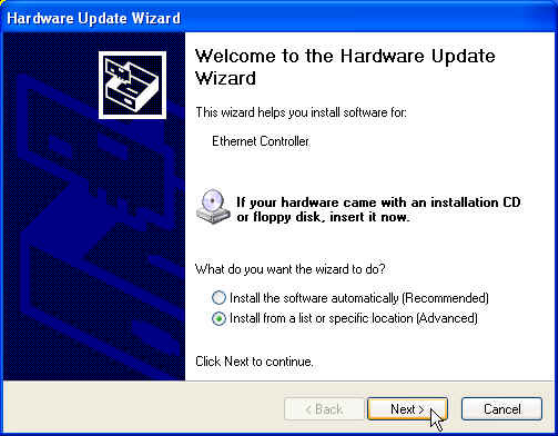
2. Installation and Overview
Here are some steps you will perform in establishing your wireless network
connection:
Installation Procedure of 802.11a/b WLAN MiniPCI Card
1. Insert the card into MiniPCI Slot.
2. Power on your computer and allow Windows to load fully.
3. The Windows will detect your Mini-PCI card and show the following screen.
Please select “Install from a list or specific location (Advanced)” and click
“Next”
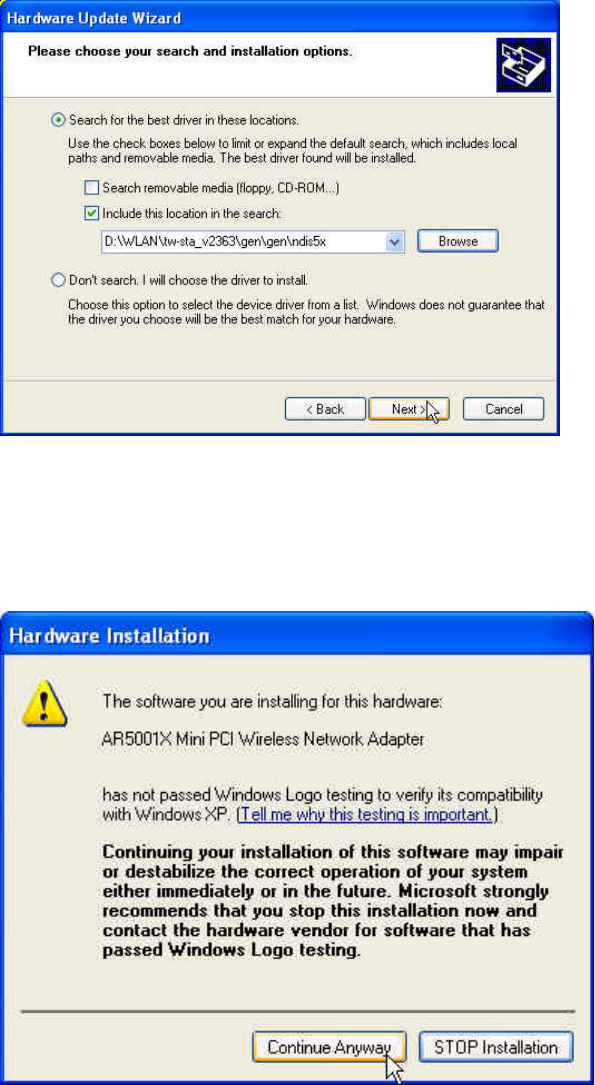
4. Select “Search for the best driver in these locations (Recommended).
Insert the given Installation Diskette and select “Include this location in the
search” to find out your driver location. Click Next to run setup.
And click “Next”
5. Now, the software you are installing for this hardware. Click “Continue
Anyway” to continue.
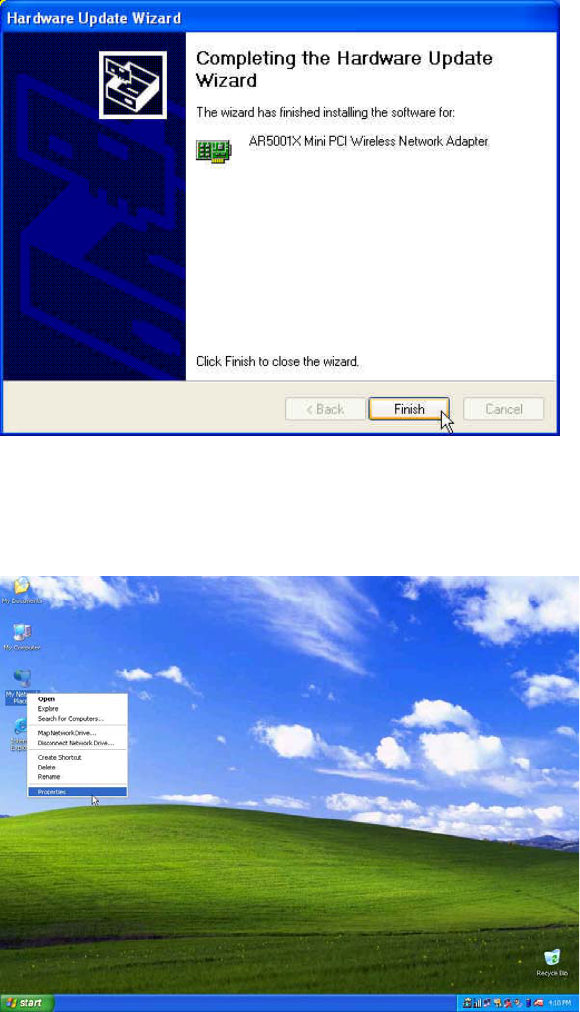
6. Click “Finished”. The installation process are completely.
7. Connect the Access Point by right clicking on My Networking using the mouse.
Select the Properties.
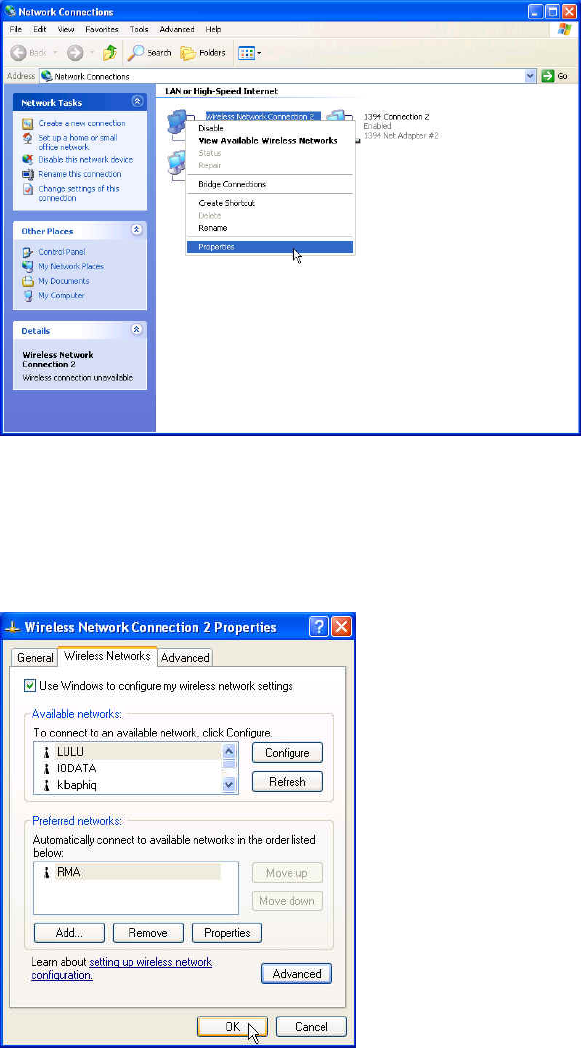
8. On the Network Connection screen, right click “Wireless Network connection
Properties” and click “Properties”.
9. On the Wireless Networks tab, please check “Use Windows to configure my
wireless network settings”. Then, select your Access Point on Available networks
dialogue and click “Configure”
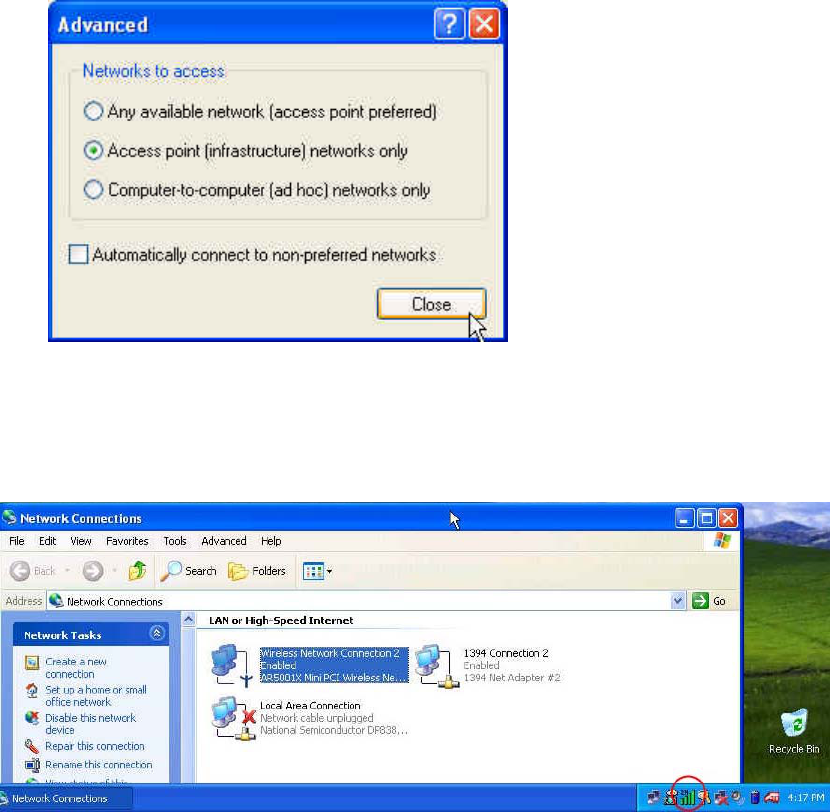
Your Access Point will show on Preferred Network tab. Please select it and click
”Advanced” to choose Networks mode
10. As you see the red circle appear, that means you connect your Access Point
successfully
Federal Communication Commission Interference Statement
This equipment has been tested and found to comply with the limits for
a Class B digital device, pursuant to Part 15 of the FCC Rules. These
limits are designed to provide reasonable protection against harmful
interference in a residential installation. This equipment generates,
uses and can radiate radio frequency energy and, if not installed and
used in accordance with the instructions, may cause harmful
interference to radio communications. However, there is no guarantee
that interference will not occur in a particular installation. If this
equipment does cause harmful interference to radio or television
reception, which can be determined by turning the equipment off and on,
the user is encouraged to try to correct the interference by one of the
following measures:
- Reorient or relocate the receiving antenna.
- Increase the separation between the equipment and receiver.
- Connect the equipment into an outlet on a circuit different from that
to which the receiver is connected.
- Consult the dealer or an experienced radio/TV technician for help.
FCC Caution: Any changes or modifications not expressly approved by
the party responsible for compliance could void the user's authority to
operate this equipment.
This device complies with Part 15 of the FCC Rules. Operation is
subject to the following two conditions: (1) This device may not cause
harmful interference, and (2) this device must accept any interference
received, including interference that may cause undesired operation.
IMPORTANT NOTE:
FCC Radiation Exposure Statement:
This equipment complies with FCC radiation exposure limits set forth for an
uncontrolled environment. This equipment should be installed and operated
with minimum distance 20cm between the radiator & your body.
This transmitter must not be co-located or operating in conjunction with
any other antenna or transmitter.

This device is intended only for OEM integrators under the
following conditions:
1) The antenna must be installed such that 20 cm is maintained between the antenna and users,
and
2) The antenna should be integral if the end device is intended to be operated in 5.15 ~ 5.25GHz
frequency range.
As long as 2 conditions above are met, further transmitter test will not be required. However, the
OEM integrator is still responsible for testing their end-product for any additional compliance
requirements required with this module installed (for example, digital device emissions, PC
peripheral requirements, etc.).
IMPORTANT NOTE: In the event that these conditions can not be met (for example certain laptop
configurations or co-location with another transmitter), then the FCC authorization is no longer
considered valid and the FCC ID can not be used on the final product. In these circumstances, the
OEM integrator will be responsible for re-evaluating the end product (including the transmitter)
and obtaining a separate FCC authorization.
Manual Information That Must be Included
The OEM integrator has to be aware not to provide information to the end user regarding how to
install or remove this RF module in the users manual of the end product which integrate this
module.
The users manual for OEM integrators end users must include the following information in a
prominent location “ IMPORTANT NOTE: To comply with FCC RF exposure compliance
requirements, the antenna used for this transmitter must be installed to provide a separation
distance of at least 20 cm from all persons and must not be co-located or operating in conjunction
with any other antenna or transmitter”.
This device operates in the in 5.15 ~ 5.25GHz frequency range and is restricted to indoor use only.